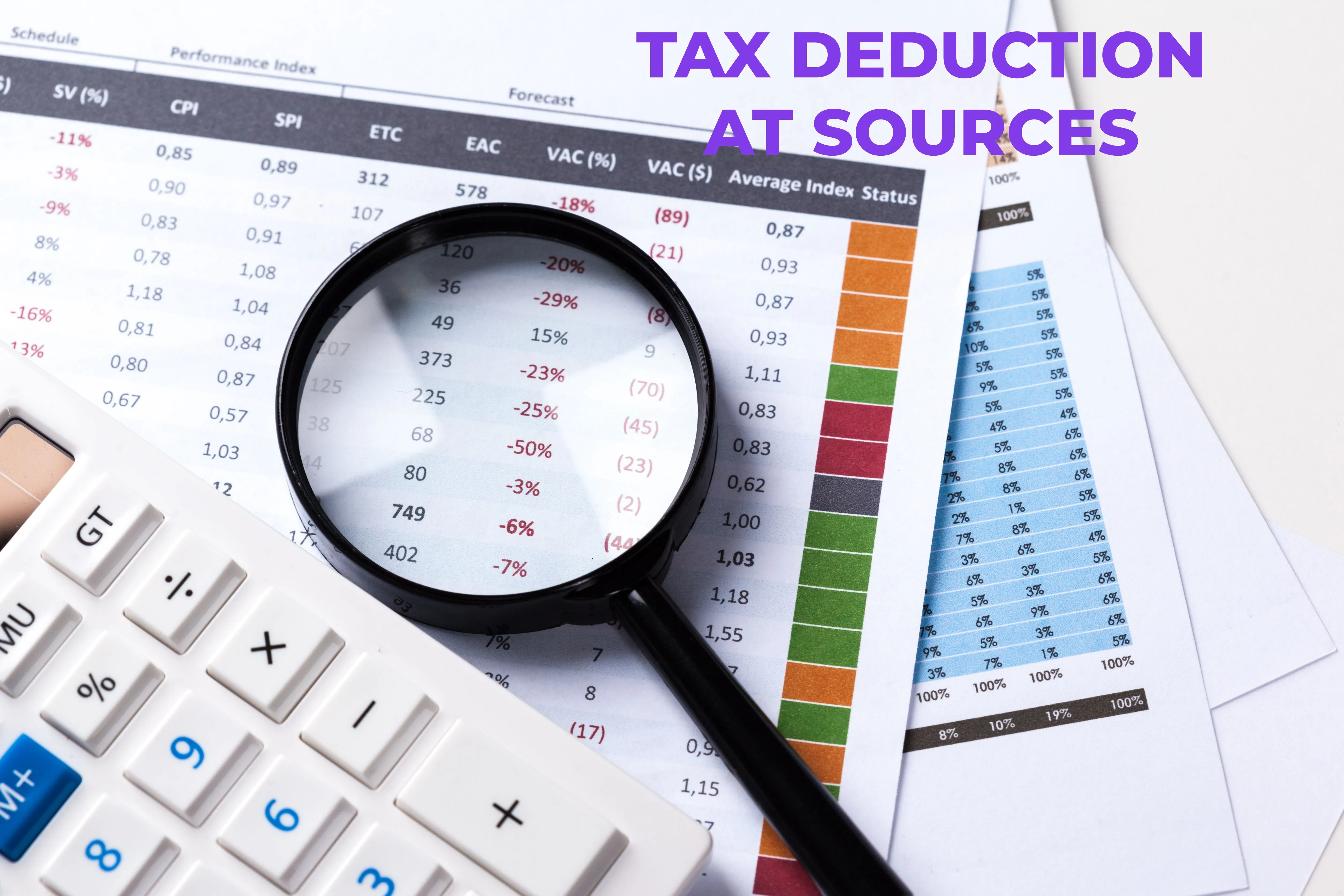10 min read Tax Deducted at Sources

Understanding TDS (Tax Deducted at Source): A Comprehensive Guide
Tax Deducted at Source (TDS) is an essential mechanism in the Indian taxation system aimed at collecting taxes at the point of income generation. Introduced by the Income Tax Department, TDS ensures that tax revenue is collected in advance and prevents tax evasion. It applies to various payments, including salaries, rent, interest, commission, and more.
This blog provides an in-depth understanding of TDS, its purpose, applicability, and compliance requirements.
What is TDS?
TDS is a system where the payer deducts tax at a specified percentage before making certain payments to the recipient. The deducted amount is then deposited with the government. For example, if a company pays interest on a loan, it may deduct tax on that interest before making the payment to the lender.
Objectives of TDS
- Prevent Tax Evasion: Ensures that tax is collected at the source of income.
- Continuous Revenue Stream: Provides the government with a steady inflow of funds throughout the year.
- Simplified Tax Collection: Reduces the burden of lump-sum tax payment for taxpayers.
Applicability of TDS
TDS is applicable to a wide range of payments, such as:
- Salaries: Employers deduct TDS from employees' salaries as per applicable income tax slabs.
- Interest Payments: Banks and financial institutions deduct TDS on interest paid on fixed deposits and other savings instruments.
- Rent: TDS is deducted on rent payments exceeding ₹2,40,000 annually.
- Professional Fees: Payments to professionals like consultants, lawyers, and freelancers attract TDS.
- Commission and Brokerage: Applicable when commission payments exceed a specified threshold.
- Purchase of Property: TDS is deducted on the purchase of immovable property (other than agricultural land) valued above ₹50 lakh.
TDS Rates
TDS rates vary depending on the type of payment. For example:
Payment TypeApplicable RateThreshold LimitSalaryAs per income slabNo threshold for deductionInterest (Bank Deposits)10%₹40,000 (₹50,000 for senior citizens)Rent (Property)10%₹2,40,000 annuallyProfessional Fees10%₹30,000 annuallyCommission/Brokerage5%₹15,000 annually
Note: Rates and thresholds are subject to periodic changes by the government.
TDS Deduction and Filing Process
- Deduction:
- The payer deducts tax from the payment at the applicable rate.
- For example, if ₹50,000 is paid as rent, the payer deducts ₹5,000 (10%) and pays the balance ₹45,000 to the landlord.
- Deposit:
- The deducted TDS must be deposited with the government by the 7th of the following month.
- TDS Return Filing:
- Payers must file TDS returns quarterly using prescribed forms:
- Form 24Q: For salary payments.
- Form 26Q: For other payments.
- Form 27Q: For payments to non-residents.
- Issue of TDS Certificate:
- After depositing the TDS, the deductor issues a TDS certificate (Form 16/16A) to the deductee.
- The certificate reflects the deducted amount and is crucial for filing income tax returns.
Non-compliance with TDS Rules
Failure to comply with TDS rules attracts penalties and interest.
- Late Deduction or Deposit:
- Interest is charged at 1% for late deduction and 1.5% for late deposit.
- Non-Filing of TDS Returns:
- A penalty of ₹200 per day is levied for delayed filing, subject to a maximum of the TDS amount.
- Incorrect Filing:
- Filing incorrect TDS returns can lead to penalties of up to ₹1,00,000.
TDS and Form 26AS
Form 26AS is a consolidated tax statement reflecting the TDS deducted on behalf of a taxpayer. It includes:
- Details of TDS deducted by various deductors.
- Advance tax and self-assessment tax paid.
- Refunds received during the financial year.
Taxpayers should verify Form 26AS before filing their income tax returns to ensure all TDS deductions are accurately recorded.
Key Exemptions from TDS
- Threshold Limits:
- Payments below specified thresholds are exempt from TDS. For example, no TDS on rent payments under ₹2,40,000 annually.
- Form 15G/15H:
- Individuals with low income can submit Form 15G (for individuals) or 15H (for senior citizens) to request exemption from TDS deduction.
- Government Payments:
- Payments made by the government to individuals or entities are generally exempt from TDS unless specifically mentioned.
Benefits of TDS
- For the Government:
- Steady revenue stream throughout the year.
- Minimizes tax evasion by capturing income data at the source.
- For Taxpayers:
- Reduces the burden of paying taxes in one lump sum.
- Encourages timely tax compliance.
Challenges in TDS Implementation
- Complexity in Compliance:
- Varying rates and thresholds can be confusing for deductors.
- Burden on Small Businesses:
- Small businesses often face challenges in maintaining compliance due to limited resources.
- Delayed Refunds:
- Errors in TDS deduction or filing may lead to delayed tax refunds for deductees.
Recent Changes in TDS Rules
The government periodically revises TDS rules to align with evolving economic conditions. Recent changes include:
- Lowering TDS rates during the COVID-19 pandemic to provide liquidity.
- Mandatory TDS on cryptocurrency transactions (1% on amounts exceeding ₹50,000 annually).
- Introduction of Section 194R: TDS at 10% on benefits or perquisites provided to professionals.
Practical Tips for TDS Compliance
- Understand Applicability:
- Familiarize yourself with TDS rates and thresholds applicable to your transactions.
- Maintain Records:
- Keep accurate records of all payments and deductions to avoid discrepancies.
- File Returns on Time:
- Adhere to deadlines for depositing TDS and filing returns to avoid penalties.
- Verify Form 26AS:
- Ensure that TDS deductions are correctly reflected in Form 26AS.
Conclusion
TDS is a cornerstone of India’s taxation system, ensuring a fair and efficient tax collection process. While it imposes compliance responsibilities on payers, it also provides significant benefits in terms of transparency and accountability.
Understanding TDS rules, adhering to compliance, and leveraging exemptions where applicable can help businesses and individuals navigate the system effectively. With regular updates and digitization, the TDS mechanism is becoming more streamlined, ensuring a win-win scenario for both taxpayers and the government.

